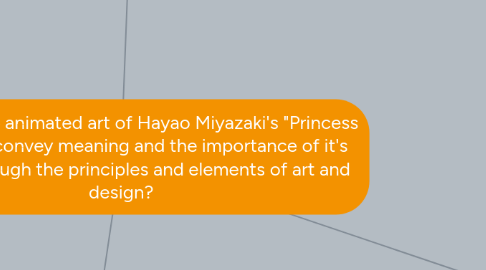
1. Sources
1.1. Books
1.1.1. Starting Point (1979-1996) - Hayao Miyazaki
1.1.2. Turning Point (1997-2008) - Hayao Miyazaki
1.1.3. "The Art and Making of Hayao Miyazaki's Princess Mononoke" - book with storyboards etc
1.2. Websites
1.2.1. http://www.awn.com/animationworld/princess-mononoke-art-and-making-japans-most-popular-film-all-time
1.2.2. http://www.japantimes.co.jp/culture/2014/08/02/books/book-reviews/deeper-look-hayao-miyazakis-nature/#.VQqgE2SUdup
2. Structure of the Essay
2.1. Introduction
2.1.1. Why I love the film
2.1.2. What is different about Miyazaki + the film
2.1.3. touch on establishing that film is art
2.2. Body
2.2.1. 1. Background of the film context and culture of the time
2.2.2. ANALYSIS of the film
2.2.2.1. Use screenshots
2.2.2.2. compare/contrast with other artists
2.2.2.3. TIME AS A FACTOR OF THE ELEMENTS AND PRINCIPLES OF ART
3. Introduction
3.1. Background Information
3.1.1. Basic information about “‘Princess Mononoke” (1997) from Studio Ghibli and created by Hayao Miyazaki (now retired). He was born in Tokyo in the year 1941. He cofounded Studio Ghibli with Isao Takahata in 1985. His films have received international acclaim, with Spirited Away winning an Oscar for “Best Animated Feature Film” in 2003
3.1.2. “Princess Mononoke” was the highest grossing film of all time in Japan.
3.1.3. The movie’s summary is about a war between humans and nature.
3.2. Principles and Elements of Art and Design
3.2.1. Elements
3.2.1.1. Line: The graphic unifier, curved, straight
3.2.1.1.1. Directional thrust: horizontal, vertical, and diagonal
3.2.1.2. Shape: Naturalistic, Geometric. (The Golden Mean)
3.2.1.3. Space/size: Large, medium, small. Proportion or scale (perspective)
3.2.2. Principles
3.2.2.1. Unity: Echoes of all elements relating
3.2.2.2. Harmony: Within each element and as a whole.
3.2.2.3. Balance: With the "weights" of the segments of each element.
3.2.2.4. Rhythm: Variety and repetition
3.2.2.5. Contrast: Alternation
3.2.2.6. Dominance: Within each element (centre of interest, focal point)
3.2.3. The principles and Elements of Art and Design are the tools used to make art deliberate.
3.3. Thesis
3.3.1. Hayao Miyazaki employs the principles and elements of art and design in order to signify and propose the true power of nature and its relationship to humankind through "Princess Mononoke."
4. BODY
4.1. Context
4.1.1. When Princess Mononoke was in the making, Studio Ghibli and Hayao Miyazaki himself were surrounded by the culture and attitude of the time during 1997, influencing the process of the movie and the decisions being made.
4.1.1.1. Art and animation at the time
4.1.1.2. Attitudes at the time (ideologies)
4.1.1.2.1. Prepare Product Evaluation
4.1.1.2.2. Conduct Product Evaluation
4.1.1.2.3. Initiate Maintenance Process
4.1.1.3. Japan culturally and contextually
4.1.1.4. Nature in the world
4.2. Hayao Miyazaki's Purpose
4.2.1. As a person, Hayao Miyazaki believes in animation as a world created of his own, in creating something that nothing else can do and to show beauty in its true form.
4.2.1.1. Childhood inspirations
4.2.1.2. Main Driving Forces
4.2.1.3. Overview of Hayao Miyazaki's life and background
4.3. Technical Aspects of Art in the Movie
4.3.1. Princess Mononoke as an art form is a masterpiece of fluid animation that captures symbols and motifs that permeate throughout the film.
4.3.1.1. Animation (smoothness)
4.3.1.1.1. Still frames vs Movement
4.3.1.1.2. What's moving and what isn't
4.3.1.1.3. Smoothness of animation
4.3.1.1.4. Frames
4.3.1.1.5. Storyboards
4.3.1.2. Importance of colour
4.3.1.2.1. Colour scheme
4.3.1.2.2. Complimentary colours
4.3.1.2.3. Colour significance
4.3.1.2.4. Meanings
4.3.1.3. ELEMENTS
4.3.1.3.1. Line
4.3.1.3.2. Spacing
4.4. Purpose/Meaning
4.4.1. The purpose of Princess Mononoke is to relay the human condition in contrast with the powerful, yet fragile nature of the forest, telling the story of their conflicts and their harmonies.
4.4.1.1. Human Condition
4.4.1.1.1. Conflict and warfare (connected to Miyazaki's upbringing)
4.4.1.1.2. Love
4.4.1.1.3. Natural state of humans (related to power)
4.4.1.2. Power of nature
4.4.1.2.1. Nature vs Humans
4.4.1.2.2. Importance of the forest
4.4.1.2.3. Fragility vs power (and how they're connected together in a cycle)
4.4.1.3. Miyazaki's main, universal purposes
4.4.1.3.1. To make movies for children
4.4.1.3.2. To make what is beautiful, beautiful and to make what is pretty, pretty
4.4.1.3.3. To take things away from the stoic plastic models (vehicles)
4.4.1.3.4. Inspiration (movies, childhood, etc)

